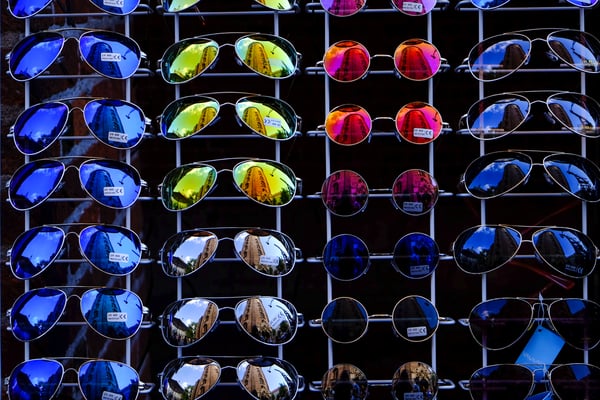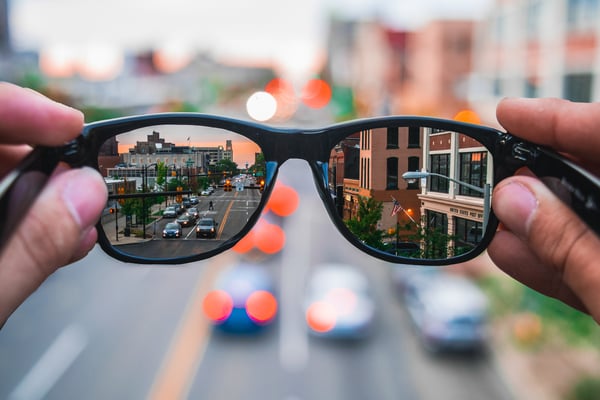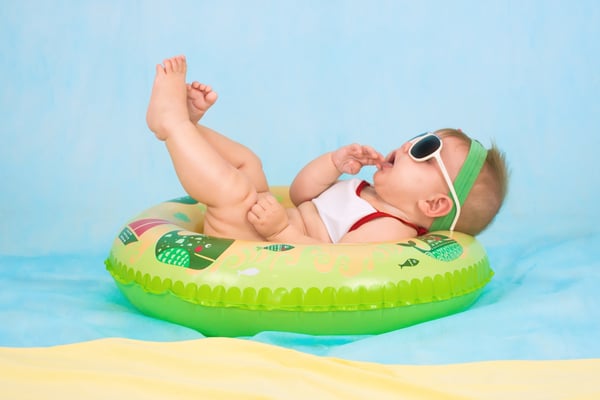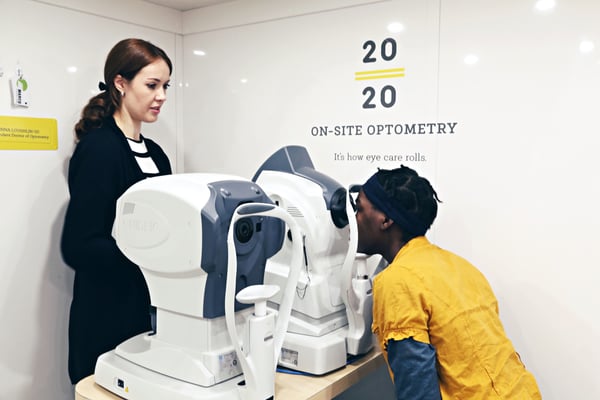Sunglasses. They’re not just for summer--to protect your eyes from harmful ultraviolet rays, you should wear them on sunny days year-round.
Here’s why. Some of the sun’s potentially negative effects on the eyes include:
- Cataracts, a clouding of the eye’s lens that can blur vision. An estimated 20% of cataracts are caused by extended UV exposure.
- Macular degeneration, resulting from damage to the retina that destroys central vision. Macular degeneration is the leading cause of blindness in the United States.
- A tissue growth over the white part of the surface of the eye, called pterygium, can alter the curve of the eyeball, causing astigmatism.
- Skin cancer of the eyelid or eye can be partially prevented by the consistent use of sunglasses.
If the last pair of sunglasses you bought was on vacation years ago, and they’ve been sitting in the bottom of your beach bag, it’s time for an upgrade. Here’s what you need to know:
1. The most important factor in your new sunglasses should be protection, and for that you need at least 99% ultraviolet (UV) coverage--both UVA and UVB. Most sunglasses have a tag with UV info on it, but be careful--those cheap glasses you see at the flea market or in the local convenience store aren’t reliable when it comes to labeling. You’re better off going a bit more upscale--to an optician or mall department store---where the cost will be higher, but where you can feel more secure that you’re buying protection, and not just colored plastic.
2. Take your favorite sunglasses with you when you shop. That way you’ll be able to compare shape and size (the nose bridge and the width of the glasses from ear to ear are the most important factors for a good fit) before you start trying on. (It doesn’t take long for selection fatigue to set in, so the closer you are to start with, the easier it will be.)

Photo by Steinar Engeland on Unsplash
3. If you have a prescription, take it to an optician. If you love the glasses you’re currently wearing, a good optician should be able to replace the lenses with your prescription. And working with an optician gives you some options, like anti-glare coating, that you may not be able to get when you choose sunglasses off a drugstore rack. Of course, you can get a whole new pair--and a benefit of going to an optician is that you’ll be able to get help finding a shape that’s flattering to your face--and a perfect fit.
4. When if comes to what style to wear, the general rule is to go for the opposite of your face shape. If your face is round, choose a square or rectangular shape. Square glasses compliment a round face. Is your face long? Look for frames that have a 1:1 proportion of length to width, and don’t let the glasses extend beyond your temples--that will only make your face look longer. You’ll want to look at rectangular glasses if your face is shaped like a triangle. Square face? Go round or for aviators.

Of course, you are at liberty to throw out all of this conventional wisdom and just pick a style you like.
Photo by Sabrina May on Unsplash
5. The color of the lens isn’t just for show--different colors have specific actions:
- Gray lenses reduce light intensity without affecting contrast or distorting colors.
- Brown lenses partially enhance contrast by blocking some blue light and are good for snow sports.
- Amber/yellow lenses significantly enhance contrast because they block most or all blue light. They’re also good for snow sports.
- Red/orange lenses are good for snow sports but only on overcast days.
- Copper-colored sunglasses will mute the sky and grass against a golf ball.
- Blue and green sunglasses enhance contrast with a yellow tennis ball.

Photo by Drew Farwell on Unsplash
6. Fit is important, and if you’re shopping without the help of an optician, there are a few important principles to bear in mind:
- Look for where the eyes are centered. Lens thickness can also be affected if the eyes are too close together or too far apart in the lens, creating thickness and distortion on the outer edges.
- The bridge of the nose piece needs to fit perfectly. When the bridge is too small, it can pinch and create a sore spot; when it's too big, it can chafe the nose and cause irritation--or slip off completely.
- The frame arms should be parallel. If they are too small, they will bow outward and stretch; if they are too large, the sunglasses will fall forward.
- The earpieces should have a good bend behind the ear in order to hold the frame in place.
- It’s never a bad idea to have a pair of grabbers for the earpieces--sunglass-wearing can be a sweaty business, and you don’t want your glasses to fall off if you’re wearing them while engaged in sports or other activities, like mowing the lawn.

Photo by Matthew Fassnacht on Unsplash
7. Spend the extra money for polarized lenses. Polarizing cuts the glare that comes from snow, water and car windows. This helps protect the eyes from sun damage better than standard UVA and UVB lenses, and will help with squinting and eye strain not only sunny days but on overcast days too, since the sun is still strong on cloudy days and can cause damage. However, beware of cheap polarized sunglasses, which can warp and cause eyestrain, headaches, or eye discomfort.
8. Take care of your glasses. A good pair of sunglasses can cost at least $50, and often into the hundreds of dollars, so protect your investment. Always carry them in a case, and don't leave them in a hot car. If they seem to be changing shape, which can happen in the heat, take them to an optician for re-fitting. Don’t clean them with anything except specially made cleansers, and only use a soft cloth to dry them off. Your optician can recommend cleansers and will often have a supply of materials you can stock up on.

Photo by Valeria Zoncoll on Unsplash
9. Don’t forget the kids. All of the same principles apply to children, who are likely to be spending a lot of time outdoors on sunny days. You may be tempted to buy the least expensive pair for them, but remember that their exposure to damaging rays is just starting. Teach them to wear their sunglasses, and how to take care of them, just as you do.

And speaking of kids, take a look at our blog, 2020 On-site Brings Eye Care To Children In Need. Of the 60,000 middle school children who have participated in our screening programs, we have found that more than half need vision correction. It’s a compelling story and we are proud of our ability to provide exams and glasses to kids who need them.


